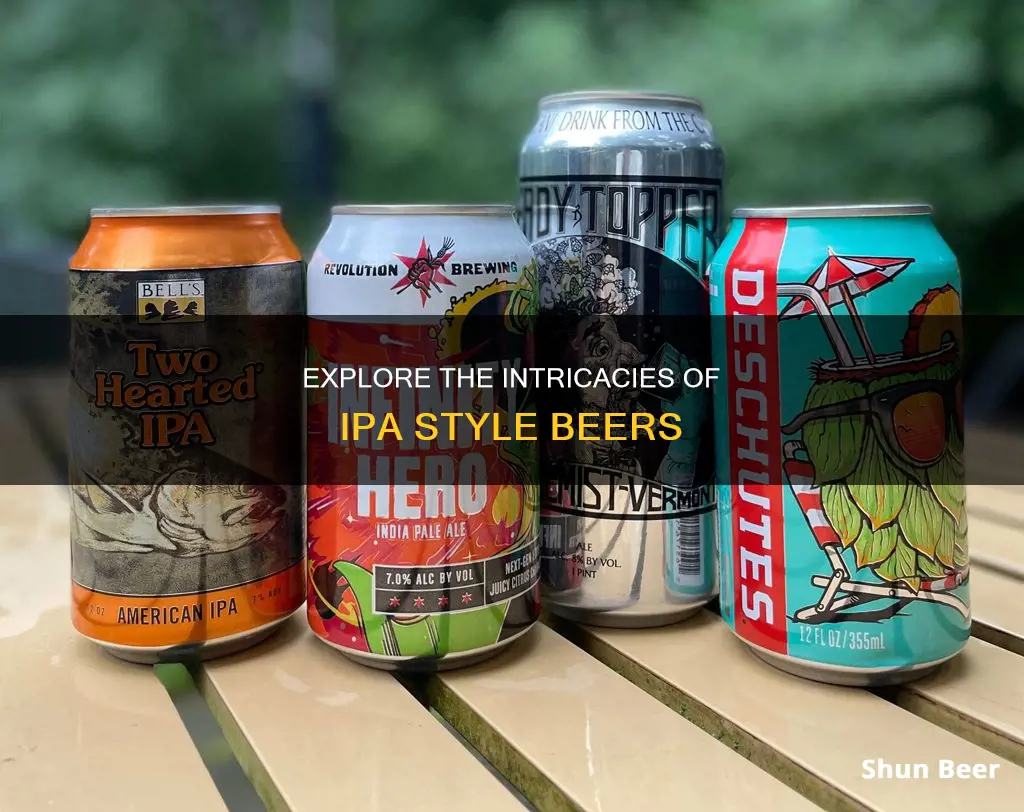
India Pale Ale (IPA) is a hoppy beer style within the broader category of pale ales. The style was first brewed in England in the 17th or 18th century and became popular in the country around 1840. IPAs are characterised by a strong hop flavour, aroma, and bitterness. The American version has a slightly more pronounced malt flavour and uses American ingredients. The popularity of the style has given rise to many variations, including East Coast, West Coast, Belgian, English, Imperial, Black, and Rye IPAs.
| Characteristics | Values |
|---|---|
| Flavour | Bitter, floral, earthy, citrusy, piney, fruity |
| Alcohol Content | 5-7.5% ABV |
| Colour | Pale gold to red, copper |
| Carbonation | Moderate to high |
| Malt | English or American |
| Hops | Cascade, Centennial, Williamette, Chinook, Citra |

The IPA's origins
The India Pale Ale (IPA) is a hoppy beer style within the broader category of pale ales. The story of the IPA begins in the 18th century, when beer was being exported to India, which was then under the control of the British East India Company. The long voyage from England to India posed a challenge, as the beer tended to spoil and go flat during the journey.
One popular origin story attributes the creation of the IPA to George Hodgson of the Bow Brewery in London. According to this narrative, Hodgson began sending his pale ale to India packed with extra hops and a higher alcohol content. The hops and alcohol acted as preservatives, ensuring the beer remained stable during the long sea journey. This resulted in a bitter and stronger pale ale that was well-suited to the hot Indian climate.
However, the true history of the IPA is more complex. While Hodgson played a significant role in popularising the style, he was not the sole inventor. By the 1760s, breweries were already aware that adding extra hops helped fortify beer for voyages to warmer climates. This practice was applied not only to pale ales but also to porters and ales. Additionally, the beer being exported was not significantly higher in alcohol content.
Hodgson's Bow Brewery gained prominence due to its proximity to the East India Company's docks and its liberal credit line of 18 months. However, the East India Company eventually sought alternative brewing partners due to Hodgson's unscrupulous business practices. They found new brewers in Burton upon Trent, including Allsopp, Bass, and Salt, who improved upon Hodgson's recipe and captured the Indian market.
By the early 19th century, "pale ale prepared for the India market" was gaining popularity, with exports and hopping levels on the rise. The first recorded mention of the phrase "India Pale Ale" appeared in 1835 in the Liverpool Mercury newspaper. The style became widely brewed in England during the 1860s, and its popularity continued to grow, with demand for the export style developing in England around 1840.
Explore the World of IPA Beers and Their Unique Taste
You may want to see also

American IPA
The American India Pale Ale (IPA) is a modern take on the traditional British IPA. The American version is a relatively new style of beer, with a history spanning only about 30 years. Its development closely coincides with the modern craft beer revolution that started in the late 1970s and gained momentum in the U.S.
The key difference between American IPAs and British IPAs lies in the brewing ingredients used, particularly the type of hops. American IPAs tend to use locally grown American hops, which impart a unique flavour profile. The result is a lighter, hoppier ale with a citrusy punch. American IPAs also tend to be fresher, as they are made to be sipped straight from the brewhouse, showcasing the glorious citrus, floral, and fruity flavours of American hop varieties.
Under the broad umbrella of American IPA, there are further sub-categories, including West Coast IPA, East Coast IPA, and New England IPA, each with its own unique characteristics and interpretations of the style.
Marble Magic: Guinness Beer's Signature Swirl
You may want to see also

Belgian IPA
India Pale Ale (IPA) is a hoppy beer style within the broader category of pale ales. IPAs come in a range of styles, and the modern approach to hoppy beer is not a declaration of bitterness but an exploration of the world of fruity flavours that can also be derived from hops.
Belgian yeast strains used in tripels and golden strong ales give the beer its fruitiness and spiciness. American examples tend to use American or New World hops, while Belgian versions tend to use European hops and only pale malt. This style may be spicier, stronger, drier, and more fruity than an American IPA.
Guinness and Breastfeeding: To Pump or Not?
You may want to see also

English IPA
India Pale Ale (IPA) is a hoppy beer style within the broader category of pale ale. The IPA was invented in Britain and was originally an export beer shipped to India, which was under the control of the British East India Company until 1858.
The pale ales of the early 18th century were lightly hopped and quite different from today's pale ales. By the mid-18th century, pale ale was brewed mostly with coke-fired malt, which produced less smoking and roasting of barley in the malting process, resulting in a paler beer. One such variety was October beer, a well-hopped brew popular among the landed gentry.
Among the first brewers known to export beer to India was George Hodgson's Bow Brewery. Its beers became popular among East India Company traders in the late 18th century due to its proximity to the East India Docks and Hodgson's liberal credit line of 18 months.
Early IPAs were only slightly higher in alcohol than other beers of the time, but more of the wort was fermented, resulting in fewer residual sugars, and they were heavily hopped. While IPAs were formulated to survive long voyages by sea, porter was also successfully shipped to India and California.
By the 1860s, India Pale Ales were widely brewed in England and were much more attenuated and hopped than porters and ales. Demand for the export style of pale ale, which became known as "India Pale Ale", developed in England around 1840.
Today, there are many variations of IPAs, including:
- Session IPAs: These have less alcohol, typically falling below 5% ABV. With lower alcohol content comes a thinner body, making them ideal for drinking in repeat.
- Double or Imperial IPAs: These IPAs have a higher hop concentration, resulting in a stronger flavour and higher ABV (usually over 7%).
- Dry-Hopped IPAs: This process involves steeping hops in fermenting beer instead of adding them during boiling. It creates an extremely strong aroma, amplifying the fruity, piney or candy-sweet notes of the hops without adding any bitterness.
- New England-style IPAs: This style of IPA is unfiltered, making it hazy, and has extremely low bitterness due to the use of hop blends that lend an intense, fruity flavour. They are often dry-hopped and fermented to have lower carbonation.
Guinness Beer and Sulfites: What's the Connection?
You may want to see also

Imperial (Double) IPA
Imperial or Double IPAs are a stronger, very hoppy variant of IPAs, typically with an alcohol content of 7.5% and above. The term "double" refers to the increased amount of ingredients used, particularly hops, resulting in a beer that is both higher in alcohol and richer in hop character compared to a standard IPA.
The style is believed to have originated with Vinnie Cilurzo, currently the owner of Russian River Brewing Company in Santa Rosa, California, in 1994 at the now-defunct Blind Pig Brewery in Temecula, California. As the legend goes, Cilurzo was attempting to create his first beer for the new brewery but, with limited equipment, he needed a way to hide any potential flaws. His solution was to double the hops and malt in his IPA recipe, resulting in an exceptionally bitter and flavourful beer.
Imperial IPAs come in a variety of hues, from pale to black, and most have a dry or medium-dry finish. They also have a higher alcohol content than traditional IPAs, typically between 7.5% and 10% ABV. When choosing food to pair with an Imperial IPA, it is recommended to keep in mind that the bitterness of the beer will amplify salty and umami flavours. Pungent cheeses such as Stilton, sharp cheddar, and blue cheese pair well with these bitter beers. Alternatively, salty cured meats like ham or grilled meats, pork chops, roast beef sandwiches, and fatty fish can be good options.
For serving, imperial IPAs can be served in a tulip glass or snifter, or even straight from the bottle or can. The ideal serving temperature is around 48 to 50 degrees Fahrenheit.
Guinness Beer: A Natural Laxative?
You may want to see also
Frequently asked questions
IPA stands for India Pale Ale. It is a hoppy beer style within the broader category of pale ales.
IPAs are known for their bitterness. They can also have floral, fruity, citrus-like, piney or resinous flavours.
Some examples of IPA beers include:
- Lagunitas IPA
- Russian River Brewing Company Blind Pig IPA
- Dogfish Head 60 Minute IPA
- Stone IPA
- Bell's Brewery Hopslam Ale







